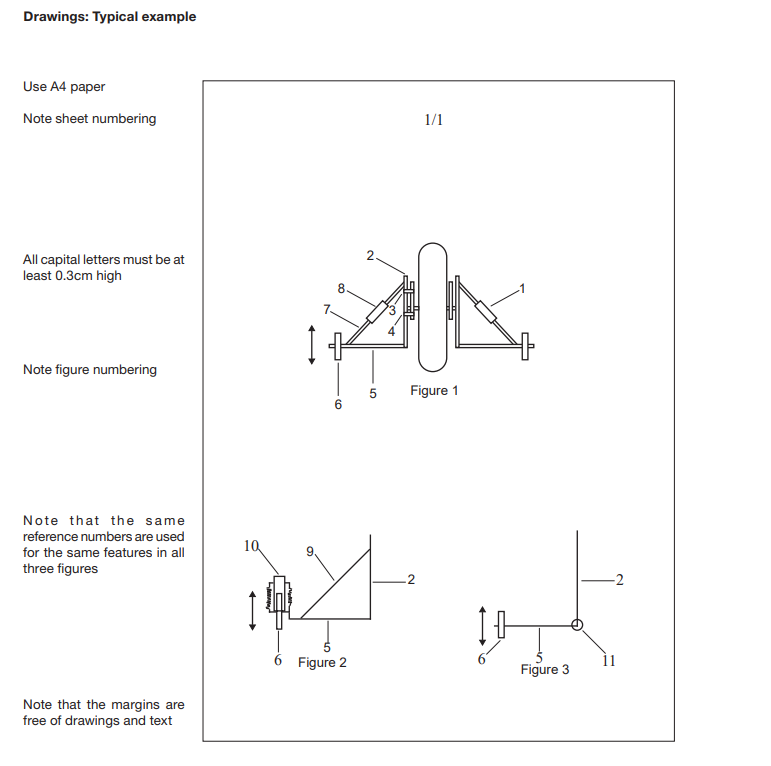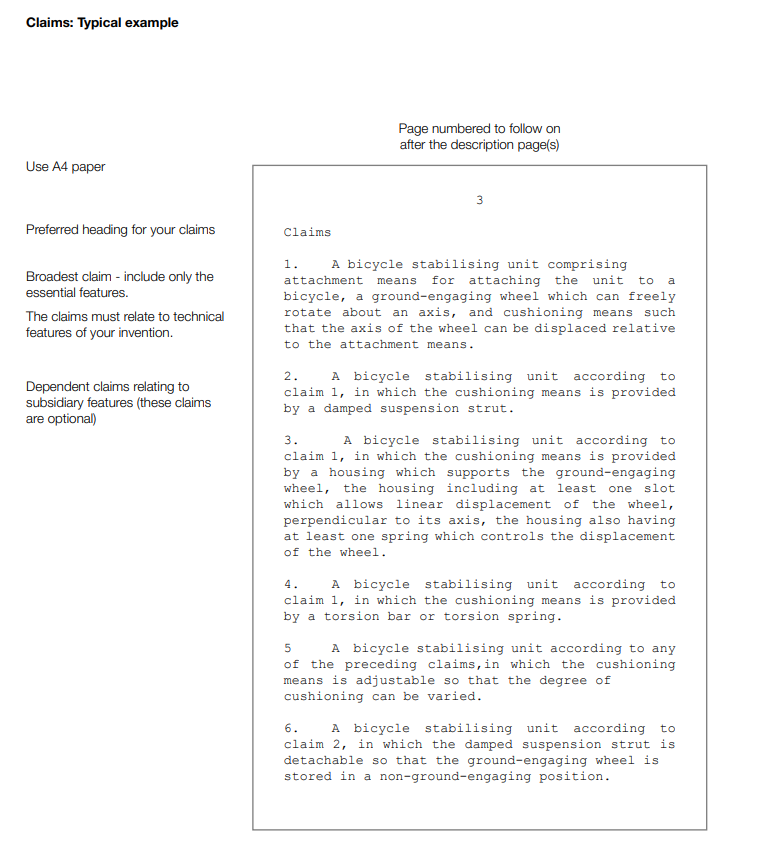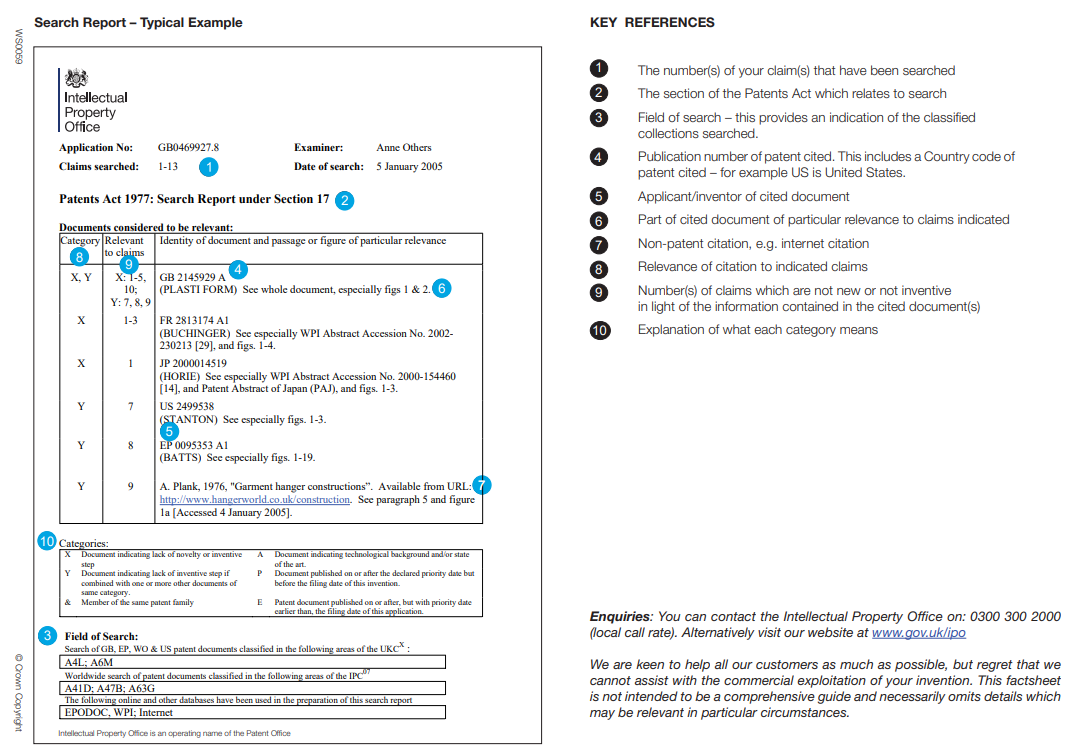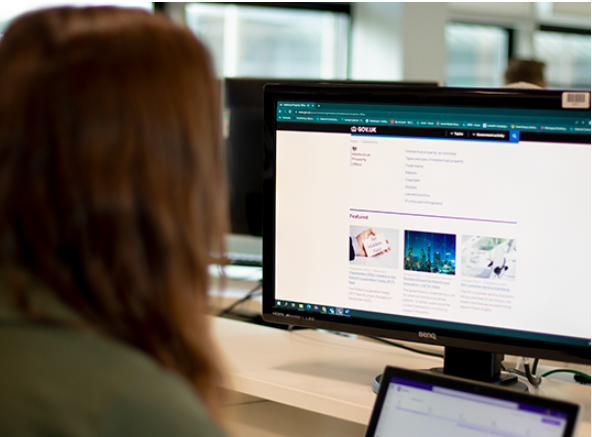Senior Developer
Intellectual Property Office
Newport
£46,262
- Digital
- Information Technology
Transform your passion for STEM into ground breaking innovation with our tailored programme, designed to put you at the forefront of the next technological wave!
Our patent examiners are an integral part of our organisation, ensuring that only inventions that meet the legal standards for patentability receive protection. This role is critical in safeguarding Intellectual Property (IP) rights and promoting innovation.
IP matters. It touches everything that makes life more enjoyable, easier, and more prosperous. It is our mission to protect IP rights so we can give inventors, creators, and investors the confidence to turn their ideas into reality and know that they will be rewarded for it.

When an individual or company has an idea for a new product, piece of apparatus, method of manufacture etc. they can decide to protect it using a patent, which if granted gives them a 20 year monopoly on their invention. To get a patent can be quite complicated so most applications come via a patent attorney.
A patent application comprises an abstract, description, possibly some drawings and a set of claims.

This is where the applicant sets out how their invention works. As patent examiners, we have to decide if the description contains enough information for a skilled person to work (make/use/do) the invention described. The description is also useful for us to understand the meaning of the claims.

The claims are an important part of the application and one patent examiners spend a lot of time thinking about. The claims set out the scope of the protection which means that claims can seem very complicated to understand.
You might have heard of patent examiners – a certain well known physicist was a patents clerk for a short while (though he was mostly distracted working on something else at the time!), but what does the patent examiner job entail day to day, and is it something you might be interested in doing?
Lets dive into the different aspects of the patent examiner job, like searching and examining patent applications! But before we get into that, lets put the job into its wider context…
There are quite a few! We have an Act and set of Rules which outline the requirements, and the Manual of Patent Practice (295 chapters) which gives us more detail on what the provisions in the Act and Rules mean and how Hearing Decisions and the Court Judgements have applied them.
When you become a patent examiner you have an initial training course [link to training page] to cover the basics and then lots of other training during your first few years. We don’t expect new patent examiners to know patent law.
Some major requirements for a patent are that the invention isn’t excluded (e.g. computer programmes, aesthetic creations, business methods), that it hasn’t been done before and isn’t obvious to the skilled person.

The first thing a patent examiner has do to is to conduct a “search”. The purpose of the search is to find documents which are most relevant to the novelty and inventive step of the application.
The majority of our searching is carried out using an online search tool built by the European Patent Office called “CST” which helps us search a database of over 100 million patent documents. In certain technology areas, we also use other databases to search for chemical compounds or biological material.
Each patent examiner is assigned to work in different technology areas, based on the Cooperative Patent Classification system (CPC). This is also the basis for most of our searching. Imagine the Dewey Decimal System that you have seen at the library but for patents. When we know the areas we need to search in, we use keywords to narrow down the documents. This often requires us to think of other ways in which the same device might have been described – a spring could also be a ‘biasing means’ or ‘elastic member’ for example.
Having narrowed down the documents to those we think are most relevant we then view them in more detail. One could say a search is similar to a mini research project you might conduct at university or in a scientific/engineering company.
It isn’t a PhD thesis however: a patent search usually only lasts between 1-2 days depending on the technology and how complicated the search is. After the search is complete, various reports are drafted – one to the applicant explaining the results of the search, the other for the examiner carrying out the substantive examination.
Although this can sometimes be carried out at the same time as the search, the substantive examination can take place a couple of years later after the patent application has been published.
The substantive examination is where the examiner decides whether the application complies with the Patents Act 1977 (as amended) and reports it to the applicant, usually via their attorney.
The examination reports explain the objection (problem) with the application to the applicant and as such are a combination of a technical report (for example explaining how a piece of prior art works and why it is relevant to the current application) and legal report (often referring to legal precedent to support an argument).
We give our new staff training on how to examine patent applications and compile reports so don’t worry if you’ve never drafted anything like that before.
After the examination report, the applicant has a number of options – they can amend their application, argue with examiner’s objections or decide not to pursue the application any further.
If they amend or argue the application comes back as an “amendment”, which is very similar to a substantive examination – the examiner must now decide whether the application complies with the Act. If it does, the examiner sends it for grant. If it doesn’t, they issue another report. In some situations where an impasse is reached, a Group Head may decide on a specific issue (a “hearing”). Should the applicant disagree with that result, they can appeal it to the courts. Patent examiners are not involved in court cases.
If the patent examiner job sounds intriguing and interesting to you, check out our Associate Patent Examiner vacancies on Civil Service jobs and apply now!
Intellectual Property Office
Newport
£46,262
There are over 400 patent examiners working at the Intellectual Property Office on every area of technology you could possibly imagine, and some you might not be able to because they’ve not been made public yet!

“At the end of the day, it’s the people at the IPO make the job for me – I’ve always been slightly in awe of the cohort of patent examiners in a single building covering all aspects of technology – a staggering conglomeration of expertise!”
Patent Examination Group Head
“I think attention to detail is really important, and a desire to tackle hard problems. Resilience is also needed – some cases can be quite challenging and require a lot of focus to produce a good product for applicants. Of course you also need to ‘know your stuff’ – but you need to be open to challenge from colleagues during your training and in discussion with applicants. Being able to recognise when you make a mistake and be open to advice is critical.”
Patent Examiner

“If you’re considering becoming a patent examiner, my advice would be to go for it! The role is a rewarding one, and the IPO provides a supportive environment with training and development opportunities to help you start a new chapter in your career.”
Patent Examiner
“I already had the technical background, so the initial two-month training course covered the Patents Act and the process of how to examine a patent application. The training was a mix of seminars and coursework, and trainees are assigned a personal tutor to guide and answer any questions. After these two months, trainees join their examining groups and start working on live applications – but the training doesn’t’ stop there – after the first year, we received another series of seminars relating to more advanced topics, with these types of seminars continuing throughout your career.“
Danielle Merrikin
Associate Patent Examiner

“The biggest benefit for me was regaining my free time. Working as a teacher, you don’t have the evenings and weekends. People think that the school holidays are when you get to recharge, but as a rare physicist, I spent the holidays preparing and writing schemes of work. I felt I was constantly working. I can enjoy the flexible working hours and have lots more time for my hobbies.”
Tara Meacham
Associate Patent Examiner
“The job is flexible. At the moment, I work from home four days a week, and from the office one day a week. The office is a great place to work, with a good canteen, coffee shop, lounge area with snooker table, pool table and darts table for relaxing at lunchtimes, and good working facilities. There are opportunities to do other things too. I have applied for the job in a service at the local school, and at the moment I am teaching Welsh in a class organized by the IPO.“
Mark Morgans
Patent Examiner
For more information on the exciting opportunity to become an Associate Patent Examiner, tune in to our live Webinar hosted by Gradcracker.
Here you will hear from three of the IPO’s patent examiners and find out where you, our STEM graduates, can fit in!
Qualifications
Applicants must hold at least a 2:2 degree in science, engineering, maths, computing, telecommunications or a related field.
Alternatively, applicants must demonstrate equivalent proficiency through substantial industrial experience in technical roles.
**currently closed for applications**
Salary: £34,958 – £36,230
Please check Civil Service Jobs for details on live vacancies.

We are seeking scientists, engineers and mathematicians with enthusiasm and energy for furthering their technical expertise to join our special organisation!
Artificial Intelligence, 6G, and quantum computing have the potential to transform our world in the next decade!
Patent examining offers a gateway to a fascinating realm where scientific and technical ingenuity meets legal acumen.
We’re seeking talented individuals with a passion for innovation and a knack for dissecting complex technical concepts to join our team as Associate Patent Examiners.
To complement the scientific and technical knowledge that you’ll bring, we’ll provide all the necessary training in the legal aspects of the role.
If you are excited about expanding your knowledge of emerging technologies, we will provide you with a personalised program of onsite training and development. This includes:
IPO are proud to sponsor exceptional talent under the Skilled Worker Route!
If you meet the Civil Service Nationality Rules, this is your chance to join an adaptable, accountable, and connected organisation, driving innovation in the UK and shaping the future together.

New examiners have an initial training course which lasts for 7 to 8 weeks and is a combination of “classroom” teaching, workshops and small group tutorial sessions.
The aim of the course is to cover the basics of patent law and the tools used to search and examination patent applications and draft search and examination reports.
Alongside the classroom teaching new examiners are allocated to a tutorial group where they discuss examples and coursework exercises.
After the initial training programme, new associate patent examiners are allocated to an examination group. Each group works on different areas of technology (e.g. biotechnology, telecoms, civil engineering, mining and drilling, heating and cooling, vehicles, measurement….), and certain groups specialise in training and managing new examiners. For most examiners their initial group will not be the technology they will end up working on for the majority of their career. All work is “revised” by their line manager who will provide detailed feedback.
During the first couple of years examiners move around line manager and technology to give them exposure to different types of technology, patent law, methods of searching and ways of writing reports. While this change may seem quite daunting, most examiners enjoy the variation in subject matter and line manager.
During the first two years, examiners have further formal training programmes – Advanced Search and Examination Training which recaps and expands upon the initial training topics, and Wider Legal Framework which covers areas of patent law beyond the day to day work (e.g. legal practice and court decisions).
Between two and five years in the office, our new B2 patent examiners will apply for promotion to C1 patent examiner. This is not a competitive promotion, it all depends on their individual work and whether they are independently proficient.
One of the things many examiners like about the job is the ongoing learning that is required.
Every patent application an examiner works on is different and requires them to work out how the invention works and how the possible citations work as well…. each case is something new to learn. We also need to keep abreast of changes in patent law as the courts make decisions be it minor variations on what has gone before, or sometimes major changes in patent practice which introduces new tests which we need to apply. New technology, such as AI, can also change how we view different areas of law.
As examiners we need to ensure our technical, legal and other (e.g. line management) skills are kept up-to-date. The IPO has various training programmes to help us do that, some of which we’ll talk about next.
After promotion examiners have the opportunity to study for a post graduate qualification in Intellectual Property Law with the University of South Wales. The course provides further knowledge of other types of IP rights (trade marks, designs, copyright) and the legal system – e.g. contract law and how the courts operate. Examiners find the chance to learn about the bigger picture and having discussions with lecturers on legal topics very enjoyable and rewarding.
There is rolling programmes of training seminars on patent law and practice and our search tools to refresh our examiners knowledge and keep them abreast of any relevant court decisions.
As examiners progress they also have the opportunity to undertake line management training to develop the skills to manage and train other examiners.
Examiners need to keep up with developments in technology and the drivers behind where firms are innovating and this is an important part of their ongoing training. This training will vary from technology to technology – for example attending trade fairs or conferences, watching industry training videos, reading articles or scientific journals. Through casework and technical training, examiners become mini-experts in their field of technology.
Beyond training for the examiner role, there are many other opportunities at the IPO to develop, both personally and professionally – such as the current Transformation project which is revolutionising our IT systems, or being on the steering group of one of our staff networks. The IPO is also very involved in the Government Science and Engineering Profession and we have examiners sitting on cross-departmental groups ranging from diversity and inclusivity to training, leadership or secondments.

For more information on how to apply for a job in the Civil Service head to:
Associate Patent Examiner
The initial application stage covers the following 3 elements:
IPO – Recruitment Support | Civil Service Careers
Check out the full advert on Civil Service Jobs.
To find out more on the Success Profiles recruitment framework visit:
Upon completion of the full time, on-site 7/8 weeks training course, the Associate Patent Examiner role will be carried out in line with IPO hybrid working arrangements where staff are currently expected to attend the office at least one day per week, or equivalent if part-time, on-site at our Newport office. You may be required to be onsite more frequently for training.
Intellectual Property Office
Newport
£46,262

A huge achievement of ours has been the creation and development of many staff networks, designed to create an environment where people feel that they belong.

Learn more on the STEM roles on offer at the IPO and what our special organisation has to offer

Keep up to date with all the latest news and updates from the Intellectual Property Office